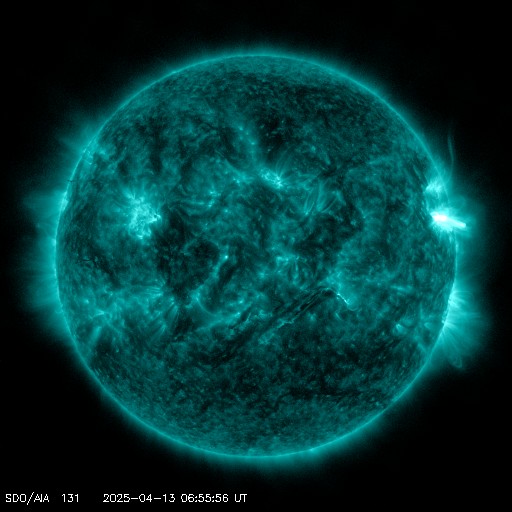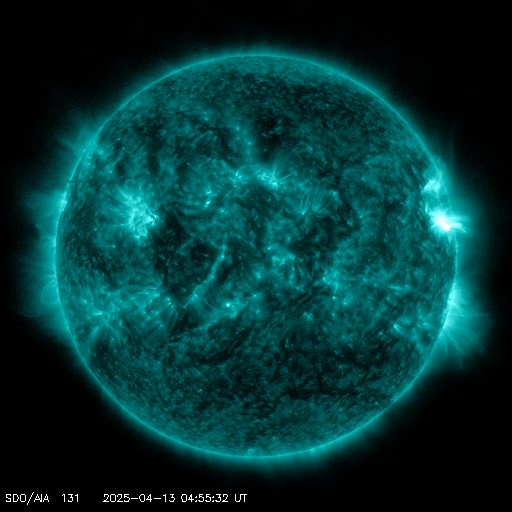Het archief bekijken van maandag 10 maart 2025
Dagelijks bulletin over zonne- en geomagnetische activiteit van het SIDC
Datum verslag: 2025 Mar 10 1231 UTC
SIDC Prognose
Zonnevlammen
C-class flares expected, (probability >=50%)
Geomagnetisme
Active conditions expected (A>=20 or K=4)
Proton Flux monitor
Quiet
| 10cm flux | Ap | |
|---|---|---|
| 10 Mar 2025 | 148 | 022 |
| 11 Mar 2025 | 152 | 012 |
| 12 Mar 2025 | 157 | 007 |
Zonnevlekkengebieden en zonnevlammen
Solar flaring activity was low over the past 24 hours, with only C-class flares identified. The largest flare was a C2.5 flare peaking on March 09 at 18:53 UTC, from a currently unnamed region from behind the east limb. A total of 5 numbered sunspot groups were identified on the disk over the past 24 hours. SIDC Sunspot Group 423 (NOAA Active Region 4012) is currently the most complex active region (Beta-Gamma magnetic configuration). Solar flaring activity is expected to be low over the next 24 hours, with C-class flares very likely and a chance for M-class flares.
Coronale massa uitstoten
No new Earth-directed Coronal Mass Ejections (CMEs) have been detected in the available coronagraph images.
Coronale gaten
A negative polarity coronal hole is crossing the central meridian. A high-speed stream from this coronal hole may impact the solar wind environment near Earth on the end of March 12.
Zonnewind
Earth continues to be under the influence of high speed stream (HSS) from the large, negative polarity coronal hole which crossed the central meridian on March 05. The solar wind speed slightly decreased from 630 km/s to 530 km/s. The interplanetary magnetic field decreased from 6 to 4 nT. The North-South component (Bz) fluctuated between -5 nT and 5 nT. In the next 24 hours, solar wind conditions at Earth may be enhanced due to the potential arrival of the ICME.
Geomagnetisme
Geomagnetic conditions were globally and locally active on March 09 between 12:00 and 15:00 UTC, and were quiet to unsettled (Kp 3 and K Bel 3) for the rest of the time. Active conditions are expected in the next 24 hours due to the potential ICME arrival.
Proton flux niveaus
The greater than 10 MeV proton flux remained below the 10 pfu threshold and is expected to remain so over the next days.
Elektronenfluxen in geostationaire baan
The greater than 2 MeV electron flux as measured by the GOES-18 satellite shortly crossed the 1000 pfu alert threshold on March 09 12:30 UTC. The greater than 2 MeV electron flux as measured by the GOES-16 satellite remained below the 1000 pfu alert threshold. The greater than 2 MeV electron flux is expected to remain below the threshold during the next 24 hours. The 24h electron fluence was at normal levels and is expected to remain so.
Het geschatte internationale zonnevlekkengetal (ISN) van vandaag: 098, gebaseerd op 19 stations.Zon indexen voor 09 Mar 2025
| Wolfgetal Catania | /// |
| 10cm zonneflux | 148 |
| AK Chambon La Forêt | 025 |
| AK Wingst | 025 |
| Geschatte Ap | 029 |
| Geschat internationaal zonnevlekkengetal | 101 - Gebaseerd op 24 stations |
Overzicht opvallende gebeurtenissen
| Dag | Start | Max | Einde | Locatie | Sterkte | OP | 10cm | Catania/NOAA | Soorten radio-uitbarstingen | |
|---|---|---|---|---|---|---|---|---|---|---|
| Geen | ||||||||||
Aangeboden door het Solar Influences Data Analysis Center© - SIDC - Verwerkt door SpaceWeatherLive
Alle tijden in UTC
<< Keer terug naar de dagelijkse overview pagina
Op basis van de huidige parameters is er in de nabije toekomst een beperkte kans op poollicht op de volgende locaties van de hoge breedtegraad
Whitehorse, YT, Yellowknife, NTFairbanks, AK
Laatste nieuws
Laatste forumberichten
Steun Poollicht.be!
Om ook bereikbaar te blijven bij grote poollichtkansen hebben we een zware server nodig die alle bezoekers aankan. Doneer en steun dit project zodat we online blijven en je geen enkele poollichtkans mist!

Laatste alerts
07:12 UTC - Zonnevlam
Matige M1.02 zonnevlam
06:54 UTC - Radio blackout
Kleine R1 radio blackout gedetecteerd (≥M1 - momenteel: M1.02)
05:12 UTC - Zonnevlam
Matige M2.31 zonnevlam
04:54 UTC - Radio blackout
Kleine R1 radio blackout gedetecteerd (≥M1 - momenteel: M1.89)
04:48 UTC - Zonnevlam
Matige M1.12 zonnevlam
Ruimteweer feitjes
| Laatste X-klasse uitbarsting | 28/03/2025 | X1.1 |
| Laatste M-klasse uitbarsting | 13/04/2025 | M2.2 |
| Laatste geomagnetische storm | 06/04/2025 | Kp5 (G1) |
| Zonnevlekkenloze dagen | |
|---|---|
| Laatste zonnevlekkenloze dag | 08/06/2022 |
| Maandelijks gemiddeld zonnevlekkengetal | |
|---|---|
| maart 2025 | 134.2 -20.4 |
| april 2025 | 136.4 +2.2 |
| Afgelopen 30 dagen | 134.7 -7.2 |





